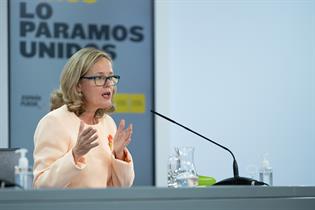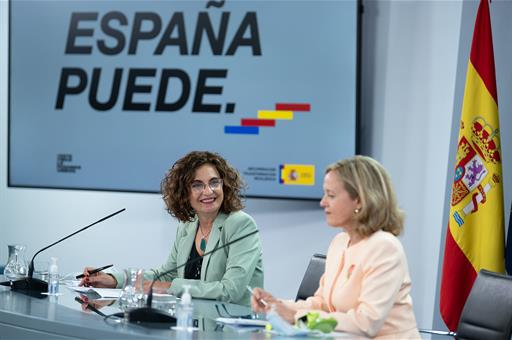Government agrees ceiling on spending for 2021 and suspends fiscal rules for this year and the next
Council of Ministers - 2020.10.6
Moncloa Palace, Madrid
The Council of Ministers agreed to set the limit on non-financial State spending for the financial year 2021 at 196.1 billion euros, and to suspend the current fiscal rules for years 2020 and 2021.
The Minister for the Treasury and Government Spokesperson, María Jesús Montero, explained that these are the first two steps in the passage of the National Budget for next year, a draft Budget which, she claimed, "is called on to lay the foundations for a change in the productive model" to make Spain "more ecological, more cohesive, fairer and better structured", and which will allow "the European Union resources to be channelled".
María Jesús Montero invited all the political formations to make contributions to achieve the maximum "support and consensus possible, because now more than ever is the time to join forces".
Higher ceiling on spending
 Pool Moncloa/Borja Puig de la BellacasaThe 196.1 billion euros of the limit on non-financial State spending, or maximum ceiling on available resources for 2021 are significantly higher than the 127.61 billion euros for 2020 since this must take into account the exceptional current context stemming from the COVID-19 pandemic, stated the minister.
Pool Moncloa/Borja Puig de la BellacasaThe 196.1 billion euros of the limit on non-financial State spending, or maximum ceiling on available resources for 2021 are significantly higher than the 127.61 billion euros for 2020 since this must take into account the exceptional current context stemming from the COVID-19 pandemic, stated the minister.
María Jesús Montero explained that the so-called "homogenous" limit on spending, which would allow a comparison with that of previous years, amounts to 136.78 billion euros. The increase is designed, among other measures, to cover the provision for the Minimum Living Income, increase items for dependency and strengthen the education system.
She added that the contributions that will be made in addition to this amount, through two extraordinary transfers, of 18.4 and 13.5 billion euros to the social security system and to the regional governments, are designed to clean up their public accounts.
She also added a first package of funding of 23.44 billion euros from the Recovery and Resilience Mechanism and from the Recovery Assistance for Cohesion and the Territories of Europe Programme-REACT-EU, approved by the European Council on 21 July in response to the coronavirus crisis.
Suspension of fiscal rules
The government decided to suspend the fiscal rules for the years 2020 and 2021, and hence "the current path of stability will be annulled and no new stability targets will be approved that accompany the ceiling on spending", stated the Minister for the Treasury.
María Jesús Montero described the measure as "extraordinary" and recalled that this is only possible because the European Union has allowed Member States to abandon, "on a temporary basis", the path of fiscal consolidation established before the crisis and because the Spanish Constitution itself contains this possibility in Article 135.4, where it states that the limits on structural debt and the volume of public debt may be exceeded "in the event of natural disasters, economic recession, and situations of extraordinary emergency".
These extraordinary circumstances, according to the same article, must be appreciated by an absolute majority of the Lower House of Parliament, and hence the government will indeed ask the Lower House to agree on this as a result of the COVID-19 pandemic.
Reference deficit rates
The Government Spokesperson warned that the fact that the ceiling on spending is not accompanied by a path of stability "does not mean, under any circumstance, that this government renounces the principle of budgetary stability", and hence neither the fiscal responsibility of the public authorities nor the principle of prudence in the estimation of revenue and expenditure will be suspended when drafting their respective budgets.
In light of the foregoing, said María Jesús Montero, the government has set reference deficit rates to serve as a guideline. The reference deficit for Spain in 2020 will be 11.3% and 7.7% for 2021. "The government's intention to start to reduce the deficit as from next year is very clear, albeit without making cuts, but rather with a policy that strengthens the Welfare State".
The Central Government deficit will stand at 5.2% (since it takes on the cost of the 31.88 billion euros in transfers to the social security system and to the regional governments), the deficit of the regional governments will stand at 1.1% and the deficit of the social security system at 1.3%.
Local authorities will have a reference deficit of approximately 0.1% and may also use treasury surpluses from this year and next, thanks to the suspension of the fiscal rules.
Report on situation of Spanish economy
 Pool Moncloa/Borja Puig de la BellacasaThe government analysed the Report on the situation of the Spanish economy which serves as the basis for drawing up the National Budget.
Pool Moncloa/Borja Puig de la BellacasaThe government analysed the Report on the situation of the Spanish economy which serves as the basis for drawing up the National Budget.
The Minister for Economic Affairs and Digital Transformation, Nadia Calviño, argued that any estimation is marked by "the high degree of uncertainty, and hence includes the necessary prudence", but that the forecast for 2021 is one of a "strong recovery of the global economy and of the Eurozone" to which the European Central Bank will contribute through an expansive monetary policy.
Within this favourable context, the minister stated that a significant recovery of the Spanish economy is expected, with a growth rate of around 7%, which could rise to 9.8% of GDP thanks to the positive impact of the measures contained in the Recovery, Transformation and Resilience Plan that the President of the Government, Pedro Sánchez, will present on Wednesday.
Nadia Calviño trusted that the additional boost from the European funds will ensure more robust, sustainable and inclusive medium-term growth and that the Spanish economy will recover levels from prior to the outbreak of the pandemic by 2022. Accordingly, she highlighted the importance of approving the National Budget as soon as possible.
Positive effects of measures adopted in 2020
The forecast for 2020 is of a fall of 11% in GDP, a much lower estimation than the 25% that was frequently heard at the start of the pandemic, according to Nadia Calviño, who stated that the measures implemented by the government have mitigated the effects of the health, economic and social crisis thanks to the mobilisation of more than 5% of GDP on budgetary support measures and more than 15% of GDP on liquidity measures.
"This has amounted to a high cost in terms of the public deficit and debt, and involved a tremendous effort by the whole of Spanish society", acknowledged Nadia Calviño, but "this has allowed the foundation of the productive fabric and jobs to be protected that the recovery will be built on".
One example highlighted by the minister was the line of Official Credit Institute (Spanish acronym: ICO) guarantees, with levels of financing disbursed that have been acknowledged by the European Central Bank as among the highest of the larger countries in the Eurozone. To the end of September, specified the minister, 834,000 operations have been signed, 98% for SMEs and independent contractors, which have allowed financing for the productive fabric to be disbursed for a sum of more than 102 billion euros.
Another example of the measures that have meant the consequences of the crisis have been limited, in this case in the labour market, are the Temporary Lay-off Plans (Spanish acronym: ERTEs), while it has been interpreted as a sign of recovery that most of the workers that signed up to these plans are now back at work. "From the peak at the end of April, when 3.4 million workers were on an ERTE, this figure has dropped by 2.7 million people, in other words more than 80% of these people are no longer on one of these plans".
However, Nadia Calviño expressed her concern over those sectors, such as retail trade and hotel and catering, which still have many people on one of these plans and the unequal regional recovery at this time. Navarre, Cantabria and Murcia, she pointed out, have recovery rates that stand at around 90%, while other regions, such as the Balearic and Canary Islands, only have recovery levels at between 40% and 60%, due to their reliance on inbound tourism.
Lastly, the minister advocated taking containment measures in those areas with new outbreaks of COVID-19, since it has been shown that public confidence has an effect on the recovery of the economy.
Other agreements
- Draft Constitutional Law to Fight Doping in Sport, which adapts Spanish legislation to the new World Anti-doping Code that will come into force on 1 January 2021.
- Approval of the "Hydrogen Roadmap: a commitment to renewable hydrogen", to help move towards the target of Spain achieving climate neutrality, with a 100% renewable electricity system, by no later than 2050.
- A 750,000-euro subsidy to the Spanish Federation of Municipalities and Provinces (Spanish acronym: FEMP) for actions by local authorities on the democratic memory, such as the exhumation and identification of people buried in mass graves during the Spanish Civil War and under the Franco regime.
- Institutional statement on the occasion of World and European Day against the Death Penalty, on 10 October.
Non official translation





